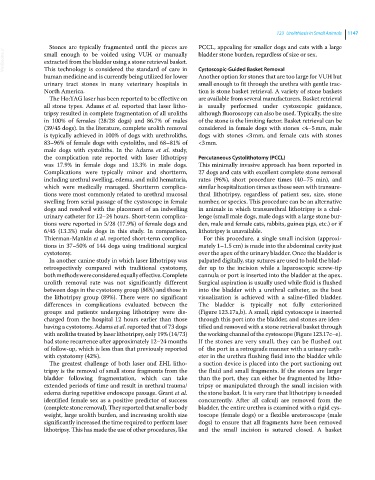Page 1209 - Clinical Small Animal Internal Medicine
P. 1209
123 Urolithiasis in Small Animals 1147
Stones are typically fragmented until the pieces are PCCL, appealing for smaller dogs and cats with a large
VetBooks.ir small enough to be voided using VUH or manually bladder stone burden, regardless of size or sex.
extracted from the bladder using a stone retrieval basket.
This technology is considered the standard of care in
Another option for stones that are too large for VUH but
human medicine and is currently being utilized for lower Cystoscopic‐Guided Basket Removal
urinary tract stones in many veterinary hospitals in small enough to fit through the urethra with gentle trac
North America. tion is stone basket retrieval. A variety of stone baskets
The Ho:YAG laser has been reported to be effective on are available from several manufacturers. Basket retrieval
all stone types. Adams et al. reported that laser litho is usually performed under cystoscopic guidance,
tripsy resulted in complete fragmentation of all uroliths although fluoroscopy can also be used. Typically, the size
in 100% of females (28/28 dogs) and 86.7% of males of the stone is the limiting factor. Basket retrieval can be
(39/45 dogs). In the literature, complete urolith removal considered in female dogs with stones <4–5 mm, male
is typically achieved in 100% of dogs with urethroliths, dogs with stones <3 mm, and female cats with stones
83–96% of female dogs with cystoliths, and 68–81% of <3 mm.
male dogs with cystoliths. In the Adams et al. study,
the complication rate reported with laser lithotripsy Percutaneous Cystolithotomy (PCCL)
was 17.9% in female dogs and 13.3% in male dogs. This minimally invasive approach has been reported in
Complications were typically minor and shortterm, 27 dogs and cats with excellent complete stone removal
including urethral swelling, edema, and mild hematuria, rates (96%), short procedure times (40–75 min), and
which were medically managed. Shortterm complica similar hospitalization times as those seen with transure
tions were most commonly related to urethral mucosal thral lithotripsy, regardless of patient sex, size, stone
swelling from serial passage of the cystoscope in female number, or species. This procedure can be an alternative
dogs and resolved with the placement of an indwelling in animals in which transurethral lithotripsy is a chal
urinary catheter for 12–24 hours. Short‐term complica lenge (small male dogs, male dogs with a large stone bur
tions were reported in 5/28 (17.9%) of female dogs and den, male and female cats, rabbits, guinea pigs, etc.) or if
6/45 (13.3%) male dogs in this study. In comparison, lithotripsy is unavailable.
Thierman‐Mankin et al. reported short‐term complica For this procedure, a single small incision (approxi
tions in 37–50% of 144 dogs using traditional surgical mately 1–1.5 cm) is made into the abdominal cavity just
cystotomy. over the apex of the urinary bladder. Once the bladder is
In another canine study in which laser lithotripsy was palpated digitally, stay sutures are used to hold the blad
retrospectively compared with traditional cystotomy, der up to the incision while a laparoscopic screw‐tip
both methods were considered equally effective. Complete cannula or port is inserted into the bladder at the apex.
urolith removal rate was not significantly different Surgical aspiration is usually used while fluid is flushed
between dogs in the cystotomy group (86%) and those in into the bladder with a urethral catheter, as the best
the lithotripsy group (89%). There were no significant visualization is achieved with a saline‐filled bladder.
differences in complications evaluated between the The bladder is typically not fully exteriorized
groups and patients undergoing lithotripsy were dis (Figure 123.17a,b). A small, rigid cystoscope is inserted
charged from the hospital 12 hours earlier than those through this port into the bladder, and stones are iden
having a cystotomy. Adams et al. reported that of 73 dogs tified and removed with a stone retrieval basket through
with uroliths treated by laser lithotripsy, only 19% (14/73) the working channel of the cystoscope (Figure 123.17c–e).
had stone recurrence after approximately 12–24 months If the stones are very small, they can be flushed out
of follow‐up, which is less than that previously reported of the port in a retrograde manner with a urinary cath
with cystotomy (42%). eter in the urethra flushing fluid into the bladder while
The greatest challenge of both laser and EHL litho a suction device is placed into the port suctioning out
tripsy is the removal of small stone fragments from the the fluid and small fragments. If the stones are larger
bladder following fragmentation, which can take than the port, they can either be fragmented by litho
extended periods of time and result in urethral trauma/ tripsy or manipulated through the small incision with
edema during repetitive endoscope passage. Grant et al. the stone basket. It is very rare that lithotripsy is needed
identified female sex as a positive predictor of success concurrently. After all calculi are removed from the
(complete stone removal). They reported that smaller body bladder, the entire urethra is examined with a rigid cys
weight, large urolith burden, and increasing urolith size toscope (female dogs) or a flexible ureteroscope (male
significantly increased the time required to perform laser dogs) to ensure that all fragments have been removed
lithotripsy. This has made the use of other procedures, like and the small incision is sutured closed. A basket

